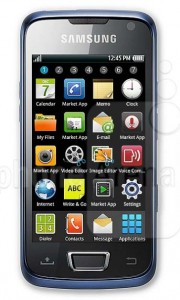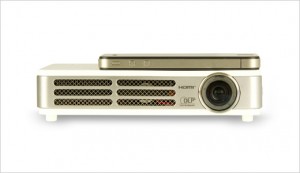 Samsung calls the P400 a micro projector, which suggests it can fit into a pocket. I consider that a gross exaggeration, unless you’re talking strictly about overcoat pockets. Nevertheless, what the P400 micro projector actually achieves is impressive enough that I won’t quibble over the description. It manages to combine a size and weight that make it highly portable with an impressively bright image for its size and unexpectedly high-quality audio.
Samsung calls the P400 a micro projector, which suggests it can fit into a pocket. I consider that a gross exaggeration, unless you’re talking strictly about overcoat pockets. Nevertheless, what the P400 micro projector actually achieves is impressive enough that I won’t quibble over the description. It manages to combine a size and weight that make it highly portable with an impressively bright image for its size and unexpectedly high-quality audio.
At 2.5 by 5.8 by 5.7 inches (HWD) and 2.0 pounds for the projector itself, plus another 1.5 pounds for the power adapter and cables, the P400 is a touch too large and heavy to fit comfortably into the palm-size, aka pocket, projector category, along with models like the 0.8-pound Dell M109S.
Setting up this projector is easy. It comes with a VGA cable and a remote. To connect to a computer, simply plug in the power block and VGA cable, point the P400 at a screen or blank wall, and adjust the focus. There’s no zoom, but you can adjust the image size by moving the projector closer to or further from the screen. On my tests, I got our standard-size image for testing (2 meters wide, or about 98 inches diagonally) from a little over 13 feet, and a somewhat smaller image, at 1.4 meters wide (67 inches diagonally), from about 8 feet.
If you need to adjust additional settings on this micro projector, you can use either the remote or the touch-sensitive controls on top of the projector. I found the touch-sensitive controls a little frustrating to use. There’s no tactile feedback, which makes it easy to overshoot the command you’re aiming for. The remote offers much surer control, making it my preferred choice. It’s smaller than most remotes, but larger—and much easier to use—than the credit-card-size remotes that often come with portable projectors.
In addition to the VGA connector on the back of the P400, there’s also a composite video connector and RCA phono plugs for stereo audio input. If you want to connect to a video source and audio, however, you’ll need to buy the cables separately.
Typical micro projectors, like the M109S, are roughly bright enough for a 40-inch-diagonal image in a dark room, or a roughly 15-inch image in a room with bright sunlight. The P400 micro projector was usable in a dark room—although a little dimmer than I’d like for long sessions—at our standard 2-meter-wide size that we use for measuring brightness. More significant, it was bright enough to be comfortable for extended viewing in a dark room with a roughly 1.6-meter-wide (approximately 81-inch-diagonal) image.
Video quality when playing a DVD was disappointing. The micro projector lost much of the detail in dark areas, and the rainbow effect was even more prominent than with computer images—to the point of being seriously annoying for those who can see it. This is not a micro projector I’d want at home for watching movies, although I’d certainly consider it for projecting video games at large size. Very much on the plus side, the audio quality was good, and the volume was surprisingly loud—much louder, in fact, than what many larger portable projectors can manage. It’s easily enough to fill a small conference room, or deliver the audio that goes with a video game.
Although the Samsung P400 micro projector video shortcomings are significant, its audio and its ability to handle computer images are more than impressive for its size and weight. For home use, I can’t recommend it for applications like watching movies, but it’s a good candidate for video games. On the business side, it’s even easier to recommend. If you need a highly portable micro projector for short presentations to small groups, I’d call it a great choice—and even more so if your presentations include sound.
 It has been some time since the release of the first micro projector. The first micro projector we came across was the AAXA M1 Standard. Back then, the M1 micro projector only had RCA input, USB data transfer and SD Card reading abilities. As technology progresses, there should be a standard for what a micro projector has in order to keep up with competition.
It has been some time since the release of the first micro projector. The first micro projector we came across was the AAXA M1 Standard. Back then, the M1 micro projector only had RCA input, USB data transfer and SD Card reading abilities. As technology progresses, there should be a standard for what a micro projector has in order to keep up with competition.












